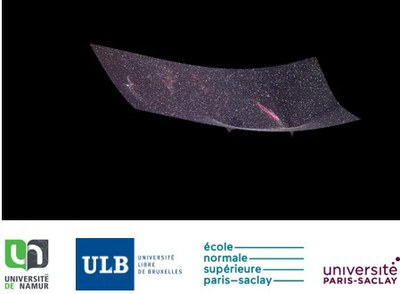A new type of gravitational wave detector to find tennis ball-sized black holes straight out of the Big Bang
French version available here...
| "Detecting primordial black holes opens up new perspectives to understand the origin of the Universe, because these still hypothetical black holes are supposed to have formed just a few tiny fractions of a second after the Big Bang. Their study is of great interest for research in theoretical physics and cosmology, because they could notably explain the origin of dark matter in the Universe". You can see stars in the eyes of the members of the team led by Professor André Fűzfa, astrophysicist at UNamur, when talking about the perspectives of their research. |
Illustration: deformation of the space-time around the Cygnus loop by two black holes. |
This project is the result of an unprecedented collaboration between the UNamur and ULB, to which the ENS added thanks to the involvement of trainee student Léonard Lehoucq. The idea was to combine the UNamur expertise in the field of gravitational wave antennas, an idea patented by Professor Fűzfa in 2018 and studied by Nicolas Herman as part of his doctorate, with that of ULB in the booming field of primordial black holes, in which Professor Clesse is one of the central players. They have just developed an application of this type of detector in order to observe "small" primordial black holes. Their results have just been published in the journal Physical Review D. “To this day, these primordial black holes are still hypothetical, because it is difficult to make the difference between a black hole resulting from the implosion of a star core and a primordial black hole. Being able to observe smaller black holes, the mass of a planet but a few centimeters in size, would make the difference,” the team of researchers says. They carry on: "We are offering experimenters a device that could detect them, by capturing the gravitational waves they emit when merging and which are of much higher frequencies than those currently detected".
But what is the technique? A gravitational wave "antenna", composed of a specific metal cavity and suitably immersed in a strong external magnetic field. When the gravitational wave goes through the magnetic field, it generates electromagnetic waves in the cavity. In a way, the gravitational wave makes the cavity "hiss" (resonate), not with sound but with microwaves.
This type of device, just a few meters in size, would be enough to detect fusions of primordial small black holes millions of light years from Earth. It is much more compact than the commonly used detectors (LIGO, Virgo and KAGRA interferometers) which are several kilometers long. The detection method makes it sensitive to very high frequency gravitational waves (in the order of 100 MHz, compared to 10-1000 Hz for LIGO / Virgo / Kagra), which are not produced by ordinary astrophysical sources such as neutron stars or stellar black holes mergers. On the other hand, it is ideal for the detection of small black holes, the mass of a planet and its size goes from a small ball to a tennis ball.

"Our detector proposal combines well mastered and everyday life technologies such as magnetrons in microwave ovens, MRI magnets and radio antennas. But don't take your household appliances apart right away to start the adventure: read our article first, then order your equipment, understand the device and the signal that awaits you at the output,” the researchers say laughingly.
This patented technique is currently at the stage of advanced theoretical modeling, but has all the necessary elements to enter a more concrete phase, with the construction of a prototype. In any case, it paves the way for fundamental research into the origins of our Universe. In addition to primordial black holes, this type of detector could also directly observe the gravitational waves emitted at the time of the Big Bang, and thus probe physics at much higher energies than the ones achieved in particle accelerators.
Discover the abstract of the article published in Physical Review D.
To better understand
Here are two animations created by the research team. The first is a simulation which combines three animations - the fusion of primordial black holes, the gravitation wave going through the detector and the induced electromagnetic power inside the detector. The second is the sound illustration, combined with visual support, of the signal coming in the detector and its response.
Animation#1 | Simulation |
Animation#2 | Sound illustration | |
|---|---|---|
A gravitational wave is equivalent to the gravity of light for the electromagnetic force: it is the interaction that propagates. Where light (electromagnetic waves) makes electric charges vibrate in its path, gravitational waves cause matter and energy to vibrate. In other words, a gravitational wave is the space-time distortion predicted by Albert Einstein in the context of General Relativity. It propagates through the Universe at the speed of light and can be produced by compact objects in close orbit, such as in the merging of black holes. The first direct detections dates back to September 2015, in the Advanced LIGO / Virgo experiment (crowned with the Nobel Prize in Physics in 2017). During its passage in an intense magnetic field, a gravitational wave generates a very weak electromagnetic signal, which could be observed thanks to specific detectors.
A black hole is such a compact astrophysical object that not even light can escape from it. For the past twenty years, observations have suggested that these extreme objects do indeed exist. Their size is directly proportional to their mass. For example, a black hole of thirty solar masses resulting from the explosion of a supernova star "measures" about 180 km. Supermassive black holes have also been discovered in the center of galaxies (Nobel Prize in Physics 2020), up to several billion times more massive than the sun. Conversely, stars cannot form black holes lighter than 1.4 times the mass of the sun and the size of a city. The observation of a "small" black hole would be the sign of an exotic origin, probably primordial.
A primordial black hole is a special type of black hole that could form very early in the history of the universe, through various processes that have shaped the fundamental interactions and the formation of particles. They may have survived to this day and formed part, if not all, of the enigmatic dark matter. Some intriguing observations, like those of LIGO / Virgo (gravitational waves) or OGLE (gravitational microlensing), could be explained by such primordial black holes.
The research team
The authors of the article published in Physical Review are:
- Nicolas Herman (UNamur): Mathematician, PhD student in the Department of Mathematics and member of the Namur Institute for Complex Systems (naXys), UNamur.
- André Fűzfa (UNamur): Astrophysicist, Cosmologist, Inventor for the occasion and Professor in the Department of Mathematics, member of the Namur Institute for Complex Systems (naXys), UNamur.
- Léonard Lehoucq (UNamur, ENS Paris Saclay): Master 1 student at the Ecole Normale Supérieure Paris-Saclay, on a research internship at UNamur
- Sébastien Clesse (ULB): Astrophysicist and Cosmologist, Professor at the Theoretical Physics Department of the Free University of Brussels
Contacts
Sébastien Clesse: sebastien.clesse@ulb.be | Nicolas Herman: nicolas.herman@unamur.be |
André Füzfa: andre.fuzfa@unamur.be
| Share this news | |||||||||||
 |
 |
||||||||||












